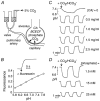Evidence against aquaporin-1-dependent CO2 permeability in lung and kidney
- PMID: 12096051
- PMCID: PMC2290384
- DOI: 10.1113/jphysiol.2001.013813
Evidence against aquaporin-1-dependent CO2 permeability in lung and kidney
Abstract
AQP1-dependent CO2 transport has been suggested from the increased CO2 permeability in Xenopus oocytes expressing AQP1. Potential implications of this finding include AQP1-facilitated CO2 exchange in mammalian lung and HCO3-/CO2 transport in kidney proximal tubule. We reported previously that: (a) CO2 permeability in erythrocytes was not affected by AQP1 deletion, (b) CO2 permeability in liposomes was not affected by AQP1 reconstitution despite a 100-fold increased water permeability, and (c) CO2 blow-off by the lung in living mice was not impaired by AQP1 deletion. We extend these observations by direct measurement of CO2 permeabilities in lung and kidney. CO2 transport across the air-space-capillary barrier in isolated perfused lungs was measured from changes in air-space fluid pH in response to addition/removal of HCO3-/CO2 from the pulmonary artery perfusate. The pH was measured by pleural surface fluorescence of a pH indicator (BCECF-dextran) in the air-space fluid. Air-space fluid pH equilibrated rapidly (t(1/2) approximately 6 s) in response to addition/removal of HCO3-/CO2. However, the kinetics of pH change was not different in lungs of mice lacking AQP1, AQP5 or AQP1/AQP5 together, despite an up to 30-fold reduction in water permeability. CO2 transport across BCECF-loaded apical membrane vesicles from kidney proximal tubule was measured from the kinetics of intravesicular acidification in response to rapid mixing with a HCO3-/CO2 solution. Vesicles rapidly acidified (t(1/2) approximately 10 ms) in response to HCO3-/CO2 addition. However the acidification rate was not different in kidney vesicles from AQP1-null mice despite a 20-fold reduction in water permeability. The results provide direct evidence against physiologically significant transport of CO2 by AQP1 in mammalian lung and kidney.
Figures




Similar articles
-
Carbon dioxide permeability of aquaporin-1 measured in erythrocytes and lung of aquaporin-1 null mice and in reconstituted proteoliposomes.J Biol Chem. 2000 Jan 28;275(4):2686-92. doi: 10.1074/jbc.275.4.2686. J Biol Chem. 2000. PMID: 10644730
-
Lung fluid transport in aquaporin-5 knockout mice.J Clin Invest. 2000 Jan;105(1):93-100. doi: 10.1172/JCI8258. J Clin Invest. 2000. PMID: 10619865 Free PMC article.
-
Role of aquaporin-4 in airspace-to-capillary water permeability in intact mouse lung measured by a novel gravimetric method.J Gen Physiol. 2000 Jan;115(1):17-27. doi: 10.1085/jgp.115.1.17. J Gen Physiol. 2000. PMID: 10613915 Free PMC article.
-
Transport of volatile solutes through AQP1.J Physiol. 2002 Jul 1;542(Pt 1):17-29. doi: 10.1113/jphysiol.2002.023218. J Physiol. 2002. PMID: 12096045 Free PMC article. Review.
-
Role of RhAG and AQP1 in NH3 and CO2 gas transport in red cell ghosts: a stopped-flow analysis.Transfus Clin Biol. 2006 Mar-Apr;13(1-2):117-22. doi: 10.1016/j.tracli.2006.03.004. Epub 2006 Mar 29. Transfus Clin Biol. 2006. PMID: 16574458 Review.
Cited by
-
Exploring transmembrane diffusion pathways with molecular dynamics.Physiology (Bethesda). 2010 Jun;25(3):142-54. doi: 10.1152/physiol.00046.2009. Physiology (Bethesda). 2010. PMID: 20551228 Free PMC article. Review.
-
Physiological roles of aquaporin-4 in brain.Physiol Rev. 2013 Oct;93(4):1543-62. doi: 10.1152/physrev.00011.2013. Physiol Rev. 2013. PMID: 24137016 Free PMC article. Review.
-
Aquaporins: translating bench research to human disease.J Exp Biol. 2009 Jun;212(Pt 11):1707-15. doi: 10.1242/jeb.024125. J Exp Biol. 2009. PMID: 19448080 Free PMC article. Review.
-
Nitric oxide conduction by the brain aquaporin AQP4.Proteins. 2010 Feb 15;78(3):661-70. doi: 10.1002/prot.22595. Proteins. 2010. PMID: 19842162 Free PMC article.
-
Role of aquaporins in lung liquid physiology.Respir Physiol Neurobiol. 2007 Dec 15;159(3):324-30. doi: 10.1016/j.resp.2007.02.012. Epub 2007 Feb 20. Respir Physiol Neurobiol. 2007. PMID: 17369110 Free PMC article. Review.
References
-
- Brion LP, Cammer W, Satlin LM, Suarez C, Zavilowitz BJ, Schuster VL. Expression of carbonic anhydrase IV in carbonic anhydrase II-deficient mice. American Journal of Physiology. 1997;273:F234–245. - PubMed
Publication types
MeSH terms
Substances
Grants and funding
LinkOut - more resources
Full Text Sources
Molecular Biology Databases

